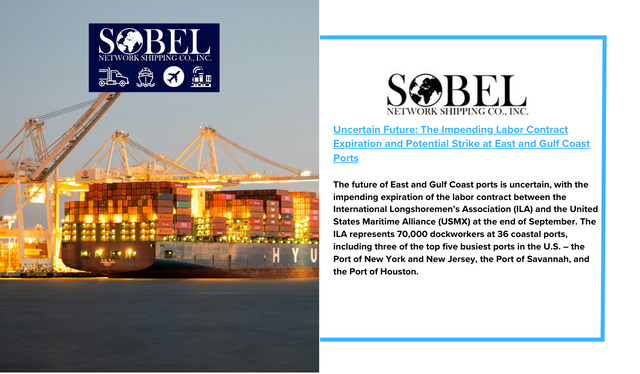The future of East and Gulf Coast ports is uncertain, with the impending expiration of the labor contract between the International Longshoremen’s Association (ILA) and the United States Maritime Alliance (USMX) at the end of September. The ILA represents 70,000 dockworkers at 36 coastal ports, including three of the top five busiest ports in the U.S. – the Port of New York and New Jersey, the Port of Savannah, and the Port of Houston.
Negotiations between the two parties began in February 2023 but quickly stalled over the issue of wage increases. Since then, there have been warnings from the ILA’s leadership about the possibility of a coastwide strike in October 2024, with no chance of extending the current contract. This has caused concern among trade associations, such as the National Retail Federation, who fear the potential impact on operations during the peak shipping season.
This uncertainty is compounded by the recent success of labor unions in securing favorable contracts, such as the Teamsters’ agreement with UPS and the United Auto Workers’ strike against major automakers. These victories have emboldened the ILA in their negotiations with the USMX.
The situation is reminiscent of the labor contract negotiations on the West Coast in 2022, which resulted in an 11-month period of confusion and chaos for importers. At its peak, 52 trade associations and industry organizations wrote to California Gov. Gavin Newsom, urging him to take action to incentivize growth at the state’s ports. The prolonged negotiations also led to a decline in market share for West Coast ports.
If negotiations between the ILA and USMX continue to deteriorate, there is a possibility of a strike that could have a significant impact on East and Gulf Coast ports. Unlike the West Coast, which primarily receives cargo from Asia, East and Gulf Coast ports receive shipments from a more diverse mix of origins, making it harder to redirect cargo to other ports.
Furthermore, the ILA has taken a firm stance against automation, targeting shipping lines directly. This could potentially lead to a swift and immediate shutdown of operations if negotiations break down.
In contrast to the West Coast, which saw a decline in market share during the prolonged negotiations, the East and Gulf Coast ports have seen a steady increase in market share. However, this could change if the ILA follows through with its strike threat.
Some argue that automation would bring new and better jobs for labor and increase throughput, providing economic benefits for all in the U.S. However, the ILA views automation as a threat to their jobs and has vowed to fight against it.
In conclusion, the future of East and Gulf Coast ports is uncertain as negotiations between the ILA and USMX continue. The ILA’s strong stance against automation and their recent victories in labor negotiations could potentially lead to a strike that could have a significant impact on operations and market share. Retailers are advised to prepare for the possibility of a strike and consider pulling forward their peak season freight to avoid potential disruptions.


